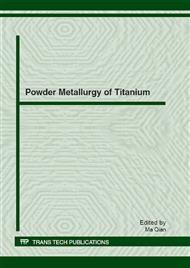[1]
R.M. German, Powder Injection Molding, Metal Powder Industries Federation, Princeton, NJ, (1990).
Google Scholar
[2]
F. Froes, Advances in titanium metal injection molding, Powder Metallurgy and Metal Ceramics 46 (2007) 303-310.
DOI: 10.1007/s11106-007-0048-y
Google Scholar
[3]
R.M. German, Status of metal powder injection moulding of titanium, International Journal of Powder Metallurgy 46 (2010) 11-17.
Google Scholar
[4]
E. Baril, Titanium and titanium alloy powder injection moulding: matching application requirements, Powder Injection Moulding International 4 (2010) 11.
DOI: 10.32657/10356/60679
Google Scholar
[5]
F.H. Froes, R.M. German, Titanium powder injection moulding (PIM), Metal Powder Report 55 (2000) 12-21.
Google Scholar
[6]
F.H. Froes, Getting better: big boost for titanium MIM prospects, Metal Powder Report 61 (2006) 20-23.
DOI: 10.1016/s0026-0657(06)70762-7
Google Scholar
[7]
R.M. German, MIM market to grow 200 million by 1995, Metal Powder Report 45 (1990) 310-316.
Google Scholar
[8]
R.M. German, Titanium powder injection moulding (Ti-PIM): A review of the current status of materials, processing, properties and applications, Powder Injection Moulding International 3 (2009) 21-37.
Google Scholar
[9]
R.M. German, R.G. Cornwall, The PIM Industry, an Industry and Market Report, Innovative Material Solutions, Inc., (1997).
Google Scholar
[10]
L.P. Lefebvre, E. Baril, Effect of Oxygen Concentration and Distribution on the Compression Properties on Titanium Foams, Advanced Engineering Materials 10 (2008) 868-876.
DOI: 10.1002/adem.200800122
Google Scholar
[11]
H. Conrad, Effect of Interstitial solutes on the strength and ductility of titanium, Progress in Materials Science 26 (1981) 123-403.
DOI: 10.1016/0079-6425(81)90001-3
Google Scholar
[12]
Y. Ikeda, S. Ikeda, S. Takaki, Effects of pores and oxygen content on mechanical properties of a sintered Ti-4 mass% Cr alloy, Journal of the Japan Society of Powder & Powder Metallurgy 42 (1995) 911-917.
DOI: 10.2497/jjspm.42.911
Google Scholar
[13]
J.A. Grohowski, B.S. Sherman, J.T. Strauss, Processing of titanium by metal injection molding, Advances in Powder Metallurgy & Particulate Materials - 2003, MPIF, Las Vegas, (2003).
Google Scholar
[14]
T. Ebel, O.M. Ferri, W. Limberg, F.P. Schimansky, Metal injection moulding of advanced titanium alloys, Advances in Powder Metallurgy & Particulate Materials-2011, MPIF, San Francisco, 2011, pp. available http: /www. mpif. org/apmimembers/papers/select028. pdf.
DOI: 10.1179/1743290112y.0000000020
Google Scholar
[15]
H. Conrad, The rate controlling mechanism during yielding and flow of α-titanium at temperatures below 0. 4 TM, Acta Metallurgica 14 (1966) 1631-1633.
DOI: 10.1016/0001-6160(66)90186-6
Google Scholar
[16]
K. Okazaki, H. Conrad, Effects of interstitial content and grain size on the strength of titanium at low temperatures, Acta Metallurgica 21 (1973) 1117-1129.
DOI: 10.1016/0001-6160(73)90028-x
Google Scholar
[17]
D. Price, A.R. Horrocks, Polymer degradation and the matching of FR chemistry to degradation, in: C.A. Wilkie, A.B. Morgan (Eds. ), Fire Retardancy of Polymeric Materials, CRC Press, (2010).
DOI: 10.1201/9781420084009-c2
Google Scholar
[18]
C.L. Beyler, M.M. Hirschler, (Eds. ), Thermal decomposition of polymers, SFPE, Boston, (1995).
Google Scholar
[19]
S.C. Moldoveanu, Analytical Pyrolysis of Synthetic Organic Polymers, Elsevier Science, (2005).
Google Scholar
[20]
Y. Kaneko, K. Ameyama, K. Saito, H. Iwasaki, M. Tokizane, Injection molding of Ti powder, Journal of the Japan Society of Powder and Powder Metallurgy 35 (1988) 646-650.
DOI: 10.2497/jjspm.35.646
Google Scholar
[21]
H. Nakamura, T. Shimura, K. Nakabayashi, Process for production of Ti sintered compacts using the injection moulding method, Journal of the Japan Society of Powder & Powder Metallurgy 46 (1999) 870-876.
DOI: 10.2497/jjspm.46.870
Google Scholar
[22]
R.M. German, A. Bose, Injection moulding of metals and ceramics, Metal Powder Industries Federation, Princeton, New Jersy, USA, (1997).
Google Scholar
[23]
W. Limberg, E. Aust, T. Ebel, R. Gerling, B. Oger, Metal Injection moulding of an advanced bone screw 7Nb alloy powder, Euro PM2004: Powder Metallurgy World Congress & Exhibition, Vienna, Austria, 2004, pp.457-462.
DOI: 10.1002/adem.200500134
Google Scholar
[24]
S. Guo, X. Qu, X. Wu, X. He, Powder injection moulding of Ti-6Al-4V alloy, Journal of Materials Processing and Technology 73 (2006) 310-314.
Google Scholar
[25]
M.Y. Cao, J.W. O'Connor, C.I. Chung, A New Water Soluble Solid Polymer Solution Binder for Powder Injection Molding, Advances in Powder Metallurgy, APMI: Princeton, 1992, pp.85-98.
Google Scholar
[26]
R.A. Einhorn, N.J. Amoroso, L.E. Bogan, Novel Feedstocks for Powder Injection Molding, (1997).
Google Scholar
[27]
A.T. Sidambe, I.A. Figueroa, H. Hamilton, I. Todd, Metal injection moulding of Ti-6Al-4V components using a water soluble binder, Powder Injection Moulding International 4 (2010) 54-62.
DOI: 10.1016/j.jmatprotec.2012.03.001
Google Scholar
[28]
A.J. Fanelli, G.B. March, J.V. Burlew, C.P. Ballard, W.S. Feri, Aqueous Process for Injection Molding Ceramic Powders at High Solid Loadings, US, (1993).
Google Scholar
[29]
MPR, Combining the best that PIM has to offer to put the bite on a new approach, Metal Powder Report 61 (2006) 22-27.
DOI: 10.1016/s0026-0657(06)70737-8
Google Scholar
[30]
K. Suzuki, T. Fukushima, Binder for injection moulding of metal powder or ceramic powder and moulding in composition and moulding method wherein the same is used, US Patent 6171360, (2001).
DOI: 10.1016/s0026-0657(01)80591-9
Google Scholar
[31]
M. Qian, Cold compaction and sintering of titanium and its alloys for near-net-shape or preform fabrication, International Journal of Powder Metallurgy 46 (2010) 29-44.
Google Scholar


